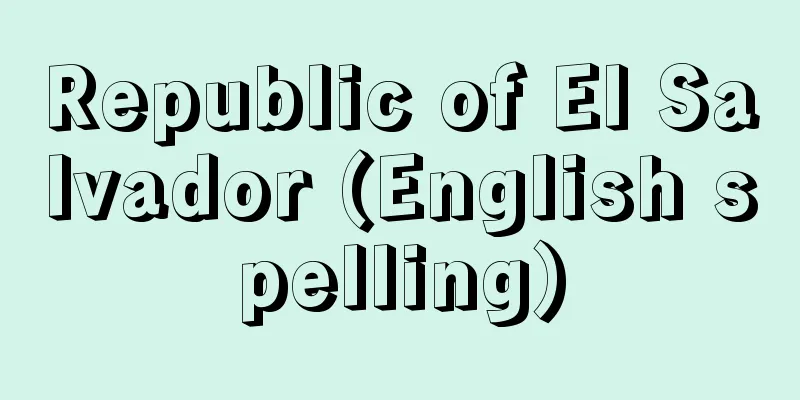Republic of El Salvador (English spelling)

|
Located almost in the center of the Central American Isthmus (a long, narrow region that connects the North and South American continents), it is a tropical country with the smallest land area and the highest population density among the seven Central American countries. Its area of 21,040 square kilometers is the combined area of Shikoku and Awaji Island in Japan. The official name is the Republic of El Salvador. It borders Honduras to the northeast and Guatemala to the northwest, and has a long coastline facing the Pacific Ocean to the south, but is the only country on the Central American isthmus that does not border the Caribbean Sea. It has a population of 6.991 million (estimated in 2006), 6.3 million (estimated in 2012), and the population of the capital, San Salvador, is about 500,000. There are about 2.5 million Mexicans living in the United States, including illegal immigrants. [Kunimoto Iyo] NatureThe country stretches in a rectangular shape from east to west along the Pacific coast, and is divided into four regions by two mountain ranges running east to west in the south and north: the lowlands on the eastern Pacific coast, the mountainous region in the southwest, the northern mountainous region, and the plateau region between the mountains at an altitude of 700 to 1,000 meters. The plateau region, which accounts for about two-fifths of the country, is cut into various parts by the valleys of the Lempa River and the San Miguel River, so agricultural and pastoral areas are scattered in narrow plains and mountain basins. The Lempa River, the country's largest river, originates in the highlands of neighboring Guatemala and Honduras, flows through the rugged country, passes through the coastal plain, and empties into the Pacific Ocean, but its floodplains are flooded in the rainy season and dry in the dry season. The eastern coastal plain is generally a fertile agricultural region, and the country's main agricultural products, such as coffee, sugar cane, and corn, are produced here. The mountainous southwestern region, which occupies one third of the country, is home to more than 20 active volcanoes, including one of the country's highest peaks, the Santa Ana Volcano (2,181 meters), and the country's largest lake, Lake Ilopango. The northern mountainous region occupies 15% of the country's land area and is home to the country's highest peak, El Pital (2,730 meters). The country's climate, although tropical, varies from region to region. The coastal areas are hot and humid, but the higher the altitude, the cooler it becomes. The average annual temperature in the capital, San Salvador, located at an altitude of about 700 meters, is 23.3°C, with little variation throughout the year. The rainy season is from May to October, with an annual rainfall of around 1,700 mm. The capital is located on the Pacific Ring of Fire, and there are many active volcanoes in various places, so volcanic eruptions and earthquakes are always devastating. San Salvador was completely destroyed by an earthquake in 1854. In 1986, the country was hit by a major earthquake that killed and injured over 20,000 people, and in 2001, an earthquake killed 1,259 people and affected 1.5 million people. [Kunimoto Iyo] historyIn the 15th century, before the Spanish arrived, indigenous peoples such as Pipil, Lenca, Pocomam, Medagalpa, and Ulua inhabited the area, and the area was called Cuscatlan, meaning "land of jewels." In 1524, a conquest force led by Spanish conquistador Pedro de Alvarado (1485-1541) arrived in the area, and the following year, 1525, he founded San Salvador. The area was under Spanish colonial rule as part of the Viceroyalty of New Spain (Mexico) until independence from Spain in 1821. The indigenous population at the time of the Spanish conquest is estimated to be about 150,000, but the number of Spaniards who settled in the area throughout the colonial period was only about 1,500. However, the indigenous population drastically decreased due to unprecedented diseases brought by the Spanish, the battles and massacres that occurred during the conquest, and the harsh labor caused by the colonial policy that followed. It gained independence from Spain in 1821 as part of the former Viceroyalty of Guatemala, but was integrated into Imperial Mexico in 1822 following the independence of the former Viceroyalty of Mexico, which had governed Central America during the colonial period. In 1824, it gained independence as the Federal Republic of Central America (1824-1840) together with Guatemala, Honduras, Nicaragua, and Costa Rica, which had formed the former Viceroyalty of Guatemala, and in 1834, San Salvador became the capital of the Federal Republic of Central America. However, the Federal Republic of Central America collapsed due to conflicts over the interests of each region and the nature of governance and administration, and El Salvador became an independent nation in 1841. After a period of political and economic turmoil following independence, liberal reforms were implemented in the 1870s, and at the same time, the coffee export economy developed, resulting in political stability. The development of a coffee monoculture economy dependent on coffee exports accelerated land concentration, and a group of wealthy families known as the "14 Families" established an oligarchic system of rule, creating an economic and social structure in which wealth was monopolized by a small number of wealthy individuals. However, the Great Depression of 1929 dealt a devastating blow to an economy dependent on coffee exports. In 1932, when the majority of the population was suffering from poverty, peasants and workers led by Agustín Farabundo Martí (1893-1932) rose in armed rebellion, aiming to establish a socialist revolutionary government. The armed rebellion was suppressed by government forces, and more than 30,000 people were massacred, while Martí himself was captured and shot. After that, through World War II, a long and intermittent fierce battle was fought between the military dictatorship and the conservative government supported by the military, and the rebel forces. During this period, the military government of Maximiliano Hernández Martínez (1882-1966), who held real power from 1931 to 1944, sympathized with European Nazism and Fascism and adopted a pro-Axis policy (a policy favoring Germany and Italy in opposition to the Allied powers such as the United States, Britain, and France). Although there was a period of reform politics during the democratization movement after World War II, from 1961 to 1979, the right-wing National Reconciliation Party (PCN: Partido de Conciliación Nacional), supported by the military, monopolized power for 18 years. At the same time, anti-government movements intensified during this time, with left-wing guerrillas taking over foreign embassies, assassinating government and business leaders, and kidnappings occurring frequently. Inspired by the 1979 Nicaraguan Revolution, guerrilla groups engaged in anti-government movements and formed the Farabundo Martí National Liberation Front (FMLN: Frente Farabundo Martí de Liberación Nacional) in 1980. Until a peace agreement was signed between the government and FMLN in January 1992 under UN mediation, the FMLN and government forces engaged in fierce fighting. This devastating civil war, which lasted for 12 years, resulted in approximately 75,000 deaths, more than one million refugees and those who fled the country, and severely weakened the domestic economy. In 1994, the first democratic elections of historic significance were held under the supervision of the international community since the end of the civil war. The FMLN, a guerrilla organization during the civil war, participated as a political party, and efforts to build a new nation began. However, the pro-American right-wing Nationalist Republican Alliance (ARENA: Alianza Republicana Nacionalista) government that was established in this election had already taken power in the 1989 presidential election, and had been in power for four consecutive terms for 20 years since then. During this time, the pro-Americanization that had progressed extended to the introduction of a dual currency system of the US dollar and the national colon in 2001, and the dispatch of troops to Iraq. However, in the congressional election held in January 2009, the FMLN, which had transformed from a former guerrilla organization into a political party, became the largest party in the parliament, and in the presidential election held in March of the same year, Mauricio Funes Carlos Mauricio Funes Cartagena (1959-), who was supported by the FMLN, was elected president, and politics entered a new era of change. [Kunimoto Iyo] PoliticsBrazil has a constitutional republic with a separation of powers, and the current constitution was enacted in 1983. The president, who serves as head of state, and the vice president are elected by direct vote of citizens over the age of 18 for a five-year term, with consecutive reelection prohibited. The parliament is unicameral, with 84 members elected for three-year terms. The country's 14 departments are centralized, with governors appointed by the president. As of 2011, the main political parties are the ruling Farabundo Martí National Liberation Front (FMLN), as well as the right-wing Nationalist Republican Alliance (ARENA), the Christian Democratic Party (PDC: Partido Democrata Cristiano), and the National Liberal Party (PLN: Partido Nacional Liberal). The Funes FMLN government, which was formed in 2009 after defeating the presidential candidate supported by the pro-American right-wing ARENA party, which had held power since 1989, advocated maintaining the previous relationship with the United States, but it has also resumed diplomatic relations with Cuba, with which it had severed diplomatic relations in 1959, maintained diplomatic relations with Taiwan, and is a member of the Central American Integration System (SICA: Sistema de la Integración Centroamericana, an intergovernmental organization of Central American countries) and the Community of Latin American and Caribbean States (CELAC: Comunidad de Estados Latinoamericanos y Caribeños), which was established in December 2011. [Kunimoto Iyo] economyIn this country, which has a small land area, an overpopulated population, and no underground resources, agriculture, forestry, and livestock farming remain important economic activities, with about 20% of the working population engaged in them as of 2009, but their share of GDP was only 12%, and the industrial structure has been changing since the late 1990s. The service industry, which is the largest sector of economic activity, accounts for about 60% of GDP, and the manufacturing sector has surpassed the primary industry to reach 28% (2010). However, looking at individual products, coffee, a traditional export product, remains the number one export item (8% range). Coffee cultivation began in the 1840s, and it replaced the dye indigo, which had been the most important export product until then, and has since become a major economic activity. The main production area is the highland area over 600 meters above sea level on the southwest foot of Santa Ana Volcano in the southwest, where it accounts for two-thirds of the total production. El Salvador industrialized in the 1960s, when the Central American Common Market (CACM) was in operation, and achieved relatively high economic growth, but from the late 1970s, the extreme uneven distribution of wealth and economic deterioration led to increased guerrilla activity, which led to civil war, and per capita income plummeted throughout the 1980s. After peace negotiations were concluded in 1992, efforts to rebuild the devastated domestic economy have been ongoing with assistance from international sources, including Japan. Industry is the most advanced of any Central American country, and processed manufacturing industries such as textiles, shoes, pharmaceuticals, food and drinking water are recovering rapidly, with exports of these light industrial products gradually replacing traditional export commodities such as coffee, sugar and cotton. El Salvador benefited greatly from the Central American Common Market, which was established in 1961, but the 1969 "Football War" (a war caused by a grudge over a soccer game) between the two countries brought the market to the brink of collapse. The market then stagnated completely due to regional conflicts in the 1970s, but has been revived in recent years as part of the movement for regional economic integration. Furthermore, in March 2006, El Salvador, along with four other Central American countries (Guatemala, Honduras, Costa Rica, and Nicaragua), signed the Central American Free Trade Agreement with the United States, and is promoting privatization and a market-based economy. The remittances sent to families in the country by an estimated 2.5 million Salvadorans living in the United States amount to about 10% of GDP, making it an important source of foreign currency. [Kunimoto Iyo] Society and Culture84% of the population is mestizo, a mix of indigenous and white people, with the remainder being white (10%) and indigenous (5.6%). Culturally, Spanish traditions and indigenous customs are maintained, but the official language is Spanish and indigenous languages have almost disappeared. Three-quarters of the population are Catholic, but in recent years there has been a remarkable increase in Protestants. Education is compulsory for a total of 12 years, including three years of preschool education from age four, and nine years of primary and secondary school, and the illiteracy rate of the population aged 15 and over is 16.6% (2010). In 1993, the ancient ruins of Joya de Cerén were registered as a UNESCO World Heritage Site (cultural heritage). [Kunimoto Iyo] Relations with JapanSince diplomatic relations were established in 1935, the two countries have traditionally maintained friendly relations, although they became enemies during World War II. In particular, after World War II, overpopulated El Salvador promoted industrialization using the industrial nation of Japan as a model, and in the 1960s, joint ventures with Japan in the cotton and chemical fiber industries boasted the largest scale in Central America. However, following the kidnapping and murder of a Japanese company president in 1978, Japanese companies began to withdraw, and relations between the two countries remained at a low level during the civil war that followed. However, Japan actively supported the national reconstruction plan after the end of the civil war. [Kunimoto Iyo] "Masuda Yoshiro and Yamada Mutsuo (eds.), Latin American History I: Mexico, Central America, and the Caribbean (1999, Yamakawa Publishing)" ▽ "Futamura Hisanori, Noda Takashi, Ushida Chizuru, and Shigaki Mitsuhiro (eds.), Latin American Modern History III (2006, Yamakawa Publishing)" ▽ "Hosono Akio and Tanaka Takashi (eds.), 55 Chapters to Understand El Salvador (2010, Akashi Shoten)" [References] | | | [Additional Resources] |"> El Salvador flag ©Shogakukan Illustration/Shogakukan Creative "> El Salvador location map An active volcano (1,950m above sea level) located west of San Salvador. It was born in 1770 as a parasitic volcano of Santa Ana Volcano. El Salvador, Santa Ana Province/Sonsonate Province ©Shogakukan "> Izalco Volcano Source: Shogakukan Encyclopedia Nipponica About Encyclopedia Nipponica Information | Legend |
|
中米地峡(南北アメリカ大陸をつなぐ紐(ひも)状の細長い地域)のほぼ中央に位置し、中米7か国のなかでもっとも国土面積が小さく、人口密度がもっとも高い熱帯の国。面積2万1040平方キロメートルは日本の四国と淡路島(あわじしま)を合わせた広さである。正式名称はエルサルバドル共和国República de El Salvador。 北東部をホンジュラスと、北西部をグアテマラと国境を接し、南は長い海岸線で太平洋に面しているが、カリブ海に面していない中米地峡の唯一の国である。人口699万1000(2006年推計)、630万(2012年推計)、首都サン・サルバドルの人口は約50万。不法滞在者を含めたアメリカ在住の同国人は約250万人である。 [国本伊代] 自然太平洋岸に沿って東西に長方形に広がる国土は、南部と北部で東西に走る二つの山脈によって太平洋岸東部の低地、南西部の山岳地帯、北部山岳地帯および山間の標高700~1000メートルの高原地帯の四つの地域に分かれている。国土の約5分の2を占める高原地帯ではレンパ川とサン・ミゲル川の渓谷が各地を寸断しているため、農牧地帯は狭隘(きょうあい)な平地と山間盆地に点在する。国内最大の河川であるレンパ川は、隣国のグアテマラとホンジュラスの高地に源をもち、起伏の多い国土を貫流して海岸平野を通過し太平洋に注ぐが、その氾濫(はんらん)原は雨季に浸水し、乾季に乾燥原となる。海岸地帯の東部平原は全般的に肥沃(ひよく)な農業地帯で、この国の主要な農産物であるコーヒー、サトウキビ、トウモロコシなどはここで生産される。国土の3分の1を占める南西部の山岳地域には20以上の活火山があり、この国の高峰の一つサンタ・アナ火山(2181メートル)や最大の湖イロパンゴ湖がある。北部山岳地域は国土の15%を占め、最高峰エル・ピタル山(2730メートル)を擁している。このような国土からなるこの国の気候は、熱帯にありながらも地域によって多様である。海岸地帯は高温多湿であるが、高度が高くなるほど涼しくなる。標高約700メートルに位置する首都サン・サルバドルの年間平均気温は23.3℃で、年間の気温差はあまりない。5月から10月までが雨期で、年間雨量は1700ミリメートル前後である。環太平洋火山帯上に首都が位置するほか、各地に多くの活火山があるため、火山の噴火と地震による被害はつねに甚大なものとなる。サン・サルバドルは1854年の地震で全壊した。また1986年には死傷者2万人を超す大地震にみまわれた。2001年の地震でも死者1259人、被災者150万人を出した。 [国本伊代] 歴史スペイン人が到来する以前の15世紀には、ピピル、レンカ、ポコマム、メダガルパ、ウルアなどの先住民族が居住しており、この地域は「宝石の土地」を意味するクスカトランとよばれていた。1524年にスペイン人征服者ペドロ・デ・アルバラードPedro de Alvarado(1485―1541)の率いる征服隊がこの地に到着し、翌1525年にサン・サルバドルを建設した。そして1821年にスペインから独立するまでヌエバエスパーニャ(メキシコ)副王領グアテマラ総督領の一部としてスペインの植民地支配下におかれた。スペインが征服した当時の先住民の人口は約15万人と推定されているが、植民地時代を通じてこの地に定住したスペイン人の数は1500人ほどにすぎなかった。しかしこれらのスペイン人が持ち込んだ未体験の疾病、征服の過程で起こった戦闘と虐殺、その後の植民地政策による過酷な労働によって、先住民の人口は激減した。 1821年に旧グアテマラ総督領の一部としてスペインから独立したが、植民地時代に中米地域を統治していた旧メキシコ副王領の独立によって1822年に帝政メキシコに統合され、1824年に旧グアテマラ総督領を形成していたグアテマラ、ホンジュラス、ニカラグアおよびコスタリカとともに中米連邦共和国(1824~1840)として独立し、1834年にサン・サルバドルが中米連邦共和国の首都となった。しかし中米連邦共和国は各地域の利害関係や統治・行政のあり方などをめぐって対立して崩壊し、エルサルバドルは1841年に独立国家となった。独立後の政治・経済の混乱期を経たのち、1870年代になって自由主義改革が実現し、同時にコーヒー輸出経済が発展すると、政治が安定した。コーヒーの輸出に依存するコーヒー・モノカルチャー(単一栽培)経済の発展は土地の集中を加速化させ、いわゆる「14家族」として知られる富裕家族が寡頭(かとう)支配体制を確立し、少数の富裕層が富を独占する経済・社会構造をつくりあげた。 しかし1929年の世界恐慌によってコーヒーの輸出に依存する経済構造は壊滅的な打撃を受けた。 国民の大多数が貧困にあえぐ1932年に、社会主義革命政権の樹立を目ざすファラブンド・マルティAgustín Farabundo Martí(1893―1932)の指揮する農民と労働者が武装蜂起(ほうき)した。この武装蜂起は政府軍によって制圧され、3万人以上が虐殺されると同時にマルティ自身も捕らえられて銃殺された。その後は第二次世界大戦を挟んで、軍事独裁政権および軍部に支援された保守政権と反政府勢力との間で熾烈(しれつ)な戦いが長期にわたって断続的に繰り広げられた。この間の1931年から1944年まで実権を握ったエルナンデス・マルティネスMaximiliano Hernández Martínez(1882―1966)の軍事政権は、ヨーロッパのナチズムとファシズムに共鳴して親枢軸政策(アメリカ、イギリス、フランスなどの連合国と対立するドイツとイタリア寄りの政策)をとった。 第二次世界大戦後の民主化運動のなかで改革のための政治が行われた時期もあったが、1961年から1979年にかけて軍部が後押しする右派の国民融和党(PCN:Partido de Conciliación Nacional)が18年間にわたって政権を独占した。同時にこの間、反政府運動が激化し、左翼ゲリラによる外国大使館の占拠や政府・財界の要人暗殺、誘拐事件が多発した。そして1979年のニカラグア革命に触発された反政府運動を展開するゲリラ諸集団は、1980年にファラブンド・マルティ民族解放戦線(FMLN:Frente Farabundo Martí de Liberación Nacional)を結成した。1992年1月に国連の調停によって政府とFMLNとの間で和平合意文書が調印されるまでの間、FMLNと政府軍は激しく戦火を交えた。12年間に及んだこの悲惨な内戦は約7万5000人の死者と100万人を超す難民・国外脱出者を生み、国内経済を極端なまでに疲弊させた。 1994年に内戦終結後、初めて歴史的な意義をもつ民主的選挙が国際社会の監視のなかで実施された。内戦中のゲリラ組織FMLNは政党として参加し、新たな国づくりへの取組みが始まった。しかしこの選挙で成立した親米右派の民族主義共和同盟(ARENA:Alianza Republicana Nacionalista)政権は、すでに1989年の大統領選挙で実権を握っており、それ以降連続4期20年にわたって政権を担当した。この間に進展した親米化は、2001年のアメリカ・ドルと自国通貨コロンによる二重通貨制度の導入やイラクへの派兵などにまで及んだ。しかし、2009年1月に行われた議会選挙で、かつてのゲリラ組織から政党へと変身したFMLNが議会で第一党となり、同年3月に行われた大統領選挙で同党が擁立したマウリシオ・フネスCarlos Mauricio Funes Cartagena(1959― )が大統領に選出されて、政治は新たな変革の時代を迎えている。 [国本伊代] 政治三権分立による立憲共和体制をとり、現行の憲法は1983年に制定されたものである。国家元首である大統領は副大統領とともに18歳以上の国民の直接選挙によって選出され、任期は5年で連続再選が禁止されている。議会は任期3年の議員84名で構成される一院制。全国14県からなる地方行政は、大統領の指名する知事が統括する中央集権体制である。主要政党には、2011年時点で政権与党のファラブンド・マルティ民族解放戦線(FMLN)のほかに、右派の民族主義共和同盟(ARENA)、キリスト教民主党(PDC:Partido Demócrata Cristiano)、国民自由党(PLN:Partido Nacional Liberal)などがある。1989年以来実権を握ってきた親米右派ARENAが擁立した大統領候補を破って2009年に成立したフネスFMLN政権は、従来の対米関係の保持を掲げながらも、1959年に外交関係を断絶したキューバとの国交を再開し、台湾との外交関係を保持し、中米統合機構(SICA:Sistema de la Integración Centroamericana。中央アメリカ諸国の政府間組織)および2011年12月に発足したラテンアメリカ・カリブ諸国共同体(CELAC:Comunidad de Estados Latinoamericanos y Caribeños)に参加している。 [国本伊代] 経済国土が狭く、人口が過密なうえに、地下資源をもたないこの国の経済活動のなかで、2009年時点でも労働人口の約20%が従事する農林牧畜業は依然として重要な経済活動であるが、GDPに占める割合は12%で、1990年代末から産業構造の変化が進んでいる。経済活動で最大の部門であるサービス産業はGDPの約60%を占め、製造業部門は一次産業を抜いて28%となった(2010)。しかし個別の産品でみると、伝統的な輸出産品であるコーヒーは依然として輸出品目の第1位(8%台)を占めている。コーヒーの栽培は1840年代に始まり、それまでもっとも重要な輸出産品であった染料のインディゴ(藍(あい))にとってかわり、以後主要な経済活動となっている。主産地は南西部のサンタ・アナ火山南西山麓(さんろく)の標高600メートルを超える高原地帯で、全生産量の3分の2を占めている。なおエルサルバドルでは中米共同市場(CACM:Central American Common Market)が機能していた1960年代に工業化が進み、比較的高い経済成長をとげたが、1970年代後半から富の極端な偏在と経済の悪化のなかでゲリラ活動が活発となって内戦状態に陥ったため、国民1人当りの所得は1980年代を通じて急落した。壊滅的な打撃を受けた国内経済は、1992年に和平交渉が成立したあと日本を含む国際的な支援を受けて復興への取組みが続けられている。工業は中米諸国のなかではもっとも進んでおり、繊維、靴、医薬品、食料・飲料水などの加工製造業が急速に回復しつつあり、これらの軽工業製品の輸出がコーヒー、砂糖、綿花などの伝統的な輸出商品にかわろうとしている。 1961年に発足した中米共同市場によってエルサルバドルは大きな恩恵を受けたが、1969年の隣国ホンジュラスと戦った「サッカー戦争」(サッカーの試合での遺恨が原因となって起きた戦争)を機に中米共同市場は解体の危機に直面した。そして1970年代以降の中米地域紛争によって完全に停滞してしまったが、近年の地域経済統合の動きのなかで復活しつつある。さらに、エルサルバドルは2006年3月に、ほかの中米4か国(グアテマラ、ホンジュラス、コスタリカおよびニカラグア)とともにアメリカとの中米自由貿易協定を発効させ、民営化と市場主義経済を進めている。推定250万人のアメリカ在住の出稼ぎエルサルバドル人の国内家族への送金額はGDPの約10%に達し、重要な外貨獲得源となっている。 [国本伊代] 社会と文化国民の84%が先住民と白人との混血であるメスティソからなり、残りは白人(10%)と先住民(5.6%)が占める。文化的にはスペインの伝統と先住民の慣習が維持されているが、公用語はスペイン語で、先住民の言語はほぼ消滅している。国民の4分の3がキリスト教カトリック信徒であるが、近年はプロテスタントの増加が著しい。教育は4歳からの就学前課程3年を含めた小・中学校9年の計12年間が義務教育で、15歳以上人口の非識字率は16.6%(2010)である。ユネスコの世界遺産(文化遺産)として1993年にホヤ・デ・セレンの古代遺跡が登録されている。 [国本伊代] 日本との関係1935年(昭和10)に外交関係が樹立されて以来、第二次世界大戦中には敵国同士となったが、伝統的に友好関係が保たれている。とくに第二次世界大戦後は人口過剰のエルサルバドルが工業国日本をモデルにして工業化を推進したこともあって、1960年代には綿・化学繊維工業における日本との合弁企業が中米最大の規模を誇っていた。しかし1978年(昭和53)に起こった日系企業社長の誘拐・殺害事件を契機に日本企業の撤退が始まり、その後の内戦状態のなかで両国関係は低いレベルに留まったが、内戦終結後の国家復興計画を日本は積極的に支援している。 [国本伊代] 『増田義郎・山田睦男編『ラテン・アメリカ史Ⅰ――メキシコ・中央アメリカ・カリブ海』(1999・山川出版社)』▽『二村久則・野田隆・牛田千鶴・志柿光浩著『ラテンアメリカ現代史Ⅲ』(2006・山川出版社)』▽『細野昭雄・田中高編著『エルサルバドルを知るための55章』(2010・明石書店)』 [参照項目] | | | [補完資料] |"> エルサルバドルの国旗 ©Shogakukan 作図/小学館クリエイティブ"> エルサルバドル位置図 サン・サルバドル西方にある活火山(標高1950m)。1770年にサンタ・アナ火山の寄生火山として誕生した。エルサルバドル サンタ・アナ州/ソンソナテ州©Shogakukan"> イサルコ火山 出典 小学館 日本大百科全書(ニッポニカ)日本大百科全書(ニッポニカ)について 情報 | 凡例 |
Recommend
Kyushu trading company
...General trading companies are found only in Ja...
Moonstone - Moonstone (English spelling)
Also known as moonstone, it is a type of potassiu...
Kadozekkyo - Kadozekkyo
〘Noun〙 In the Edo period, a person who wore a haor...
Statute of limitations - statute of limitations
The duration of rights established to quickly det...
Kadenmin
Farmers who practice slash-and-burn agriculture in...
Otomo no Kuronushi
Years of birth and death unknown. A poet of the e...
Rice Dyeing - Kachizome
…Izumi vinegar and Bingo sake are particularly no...
Leonurus macranthus (English spelling) Leonurusmacranthus
…[Murata Gen]. … *Some of the terminology that me...
Marañón, Gregorio
Born: May 19, 1887 in Madrid [Died] March 27, 1960...
Ethiopic languages - Ethiopia Shogo (English spelling)
A general term for the Semitic languages spoken ...
Toga (English spelling)
Toga. A wrap-style outer garment commonly worn by ...
Financial Markets
This refers to the phenomenon in which trading of ...
Slope production method - Keisha Seisan Houshiki
A prioritized production policy adopted to rebuil...
Rhabdocalyptus capillatus (English spelling) Rhabdocalyptus capillatus
… [Minoru Imajima]. … *Some of the terminology th...
Valonia (English spelling)
A seaweed of the family Valoniaceae in the order A...









